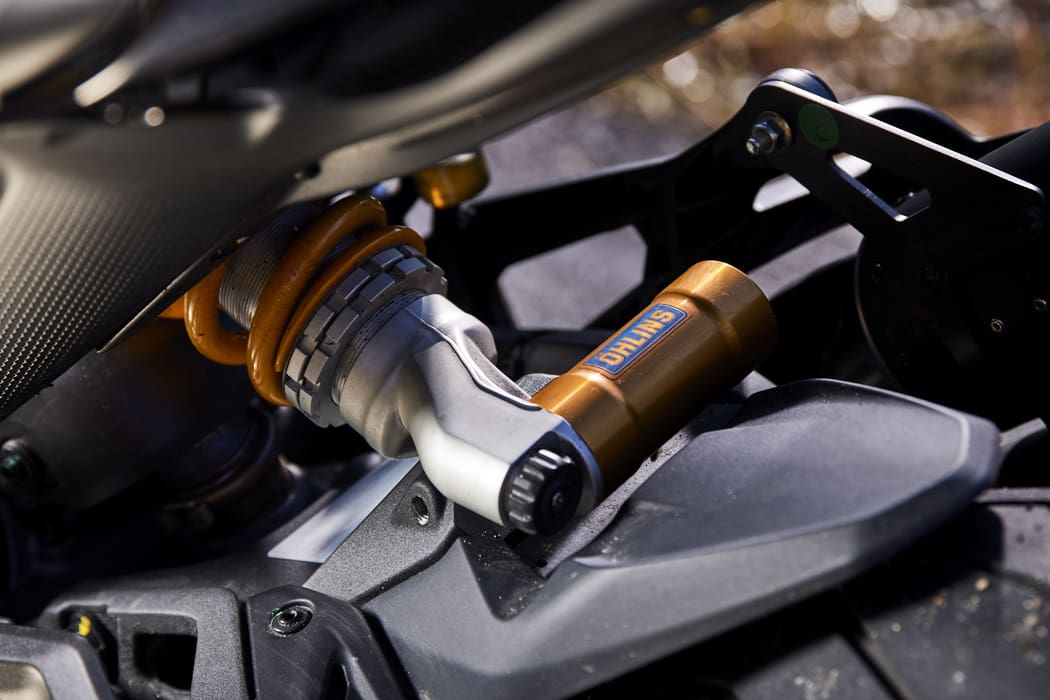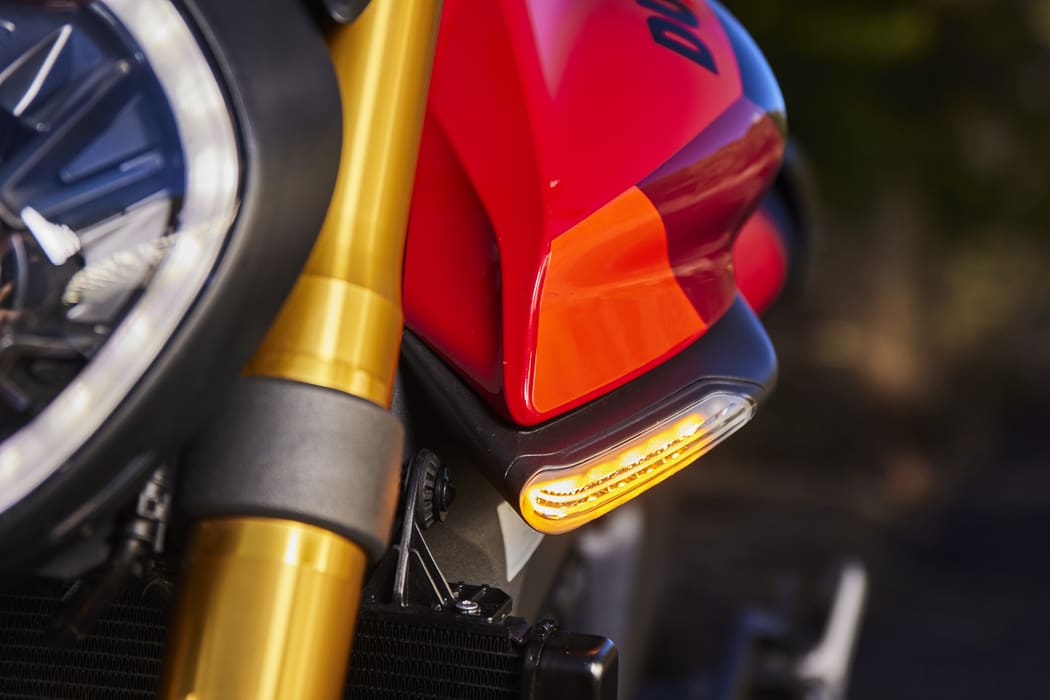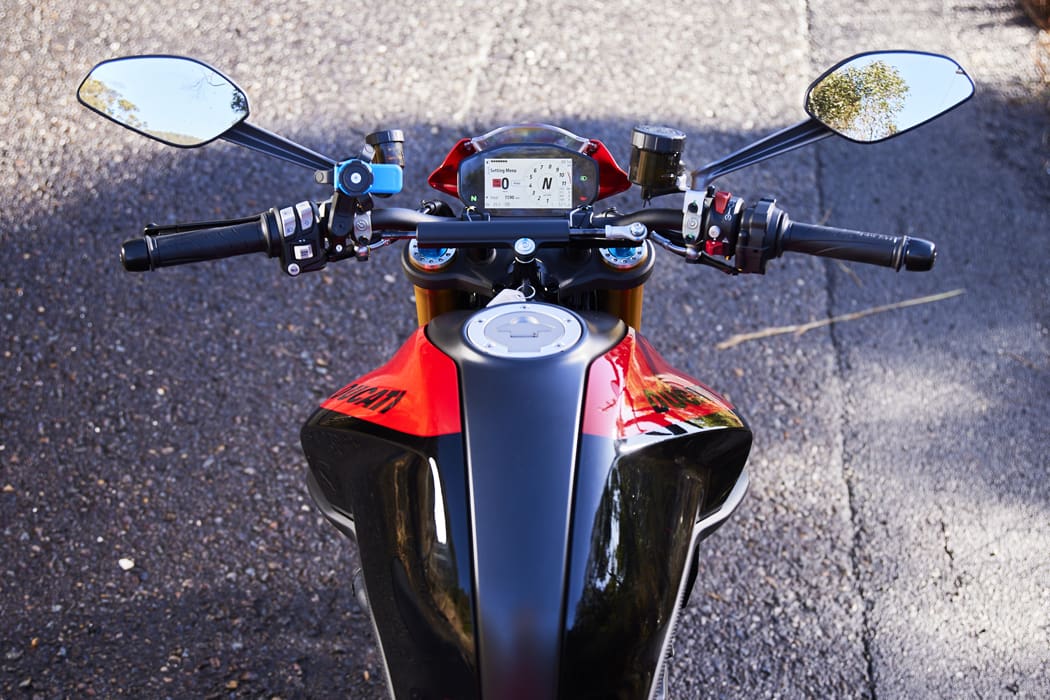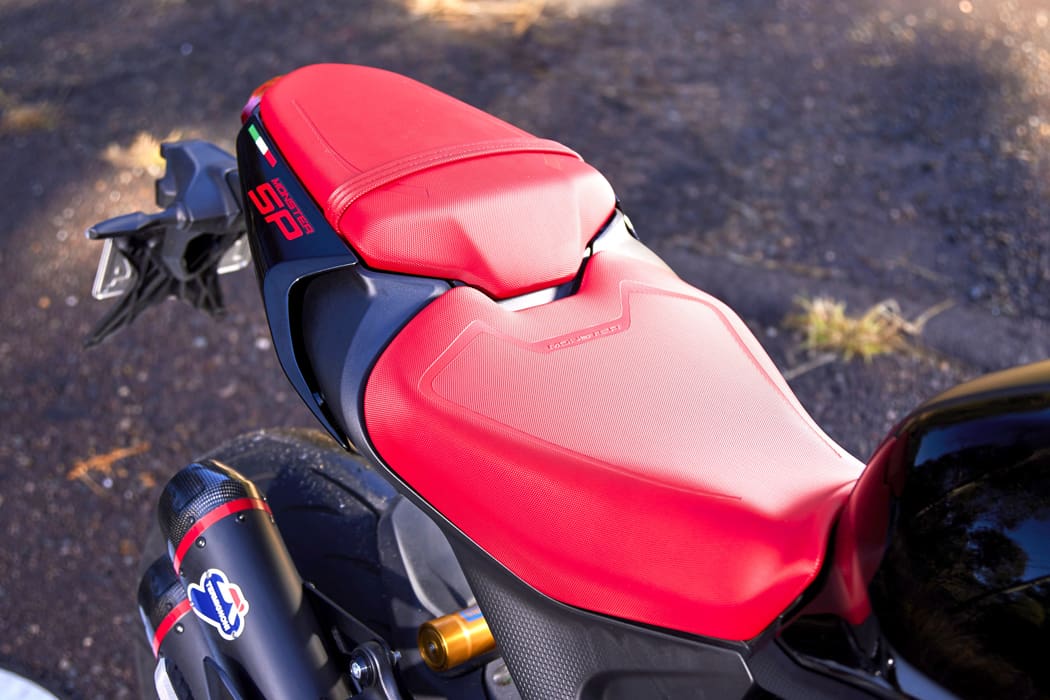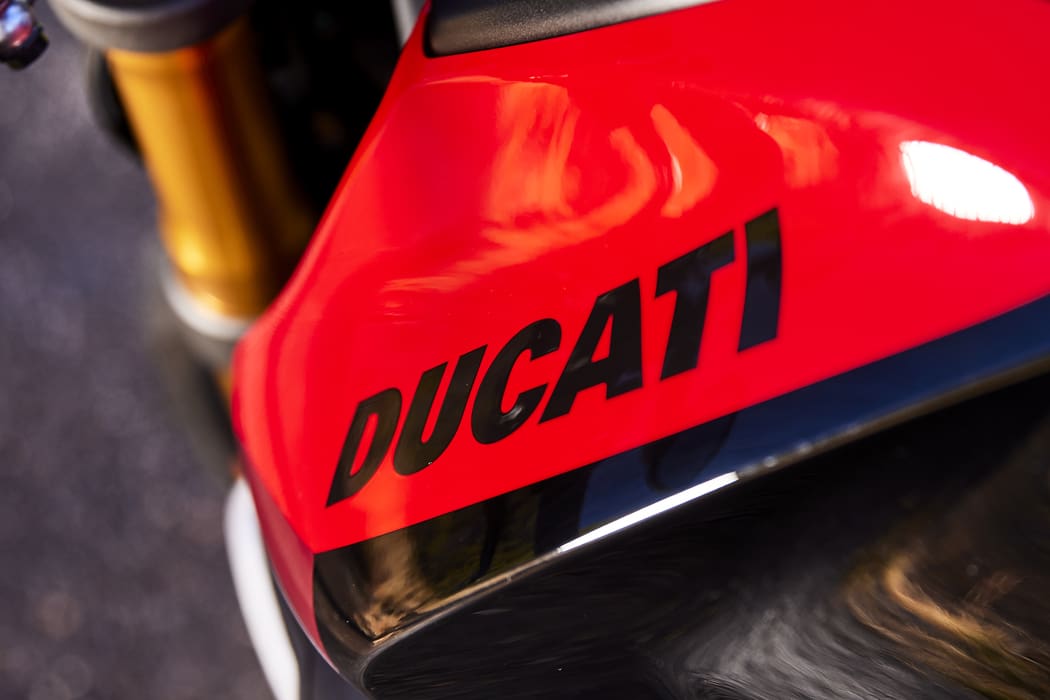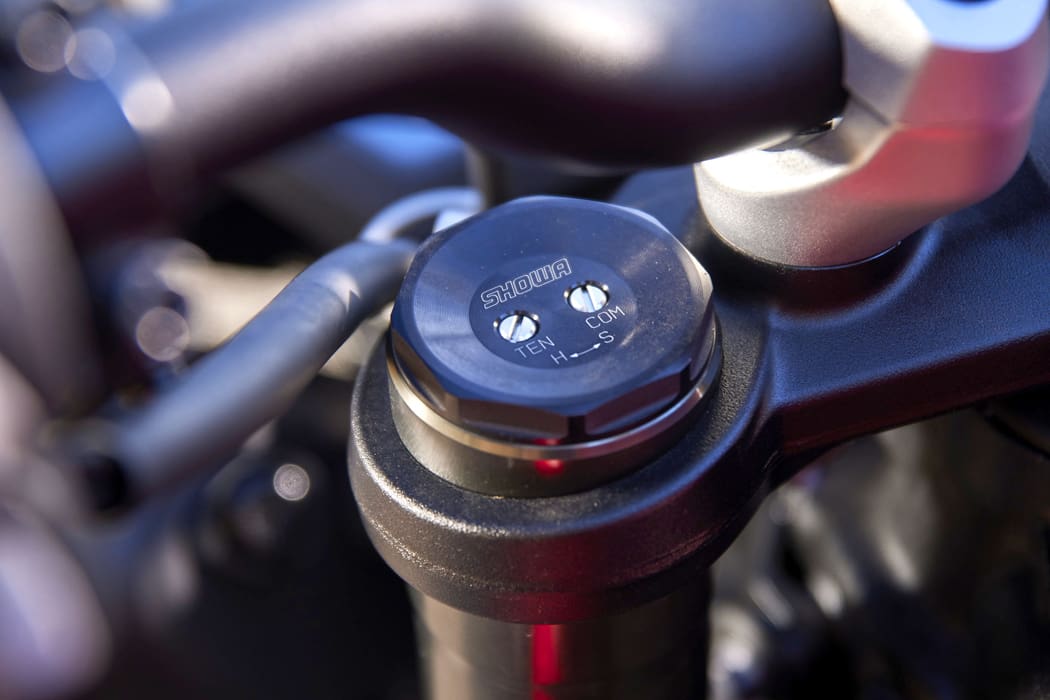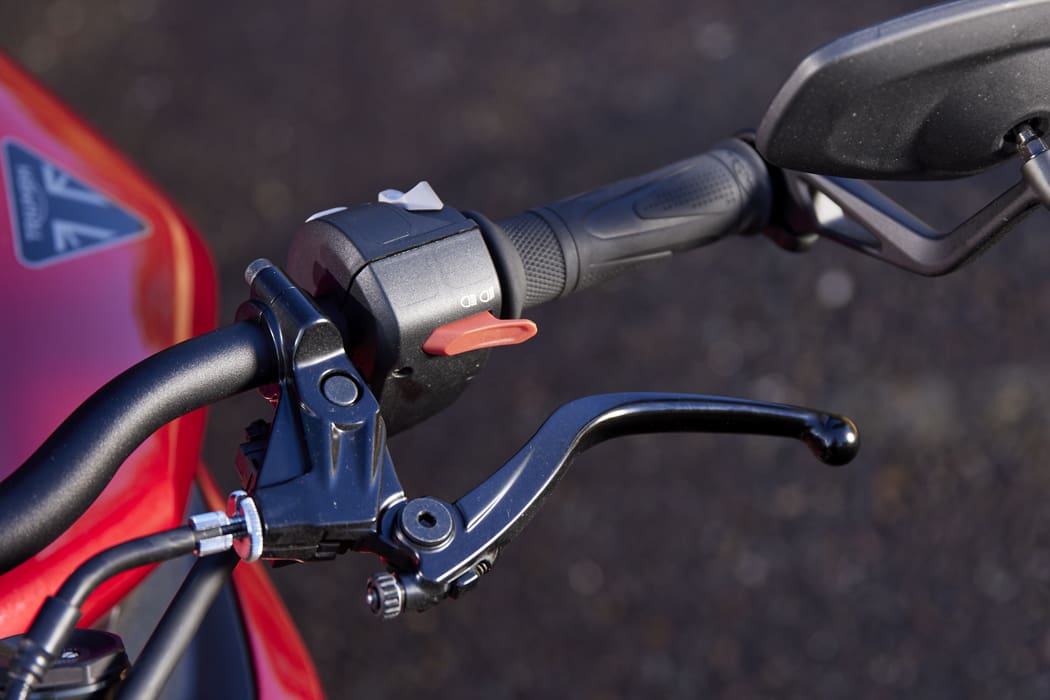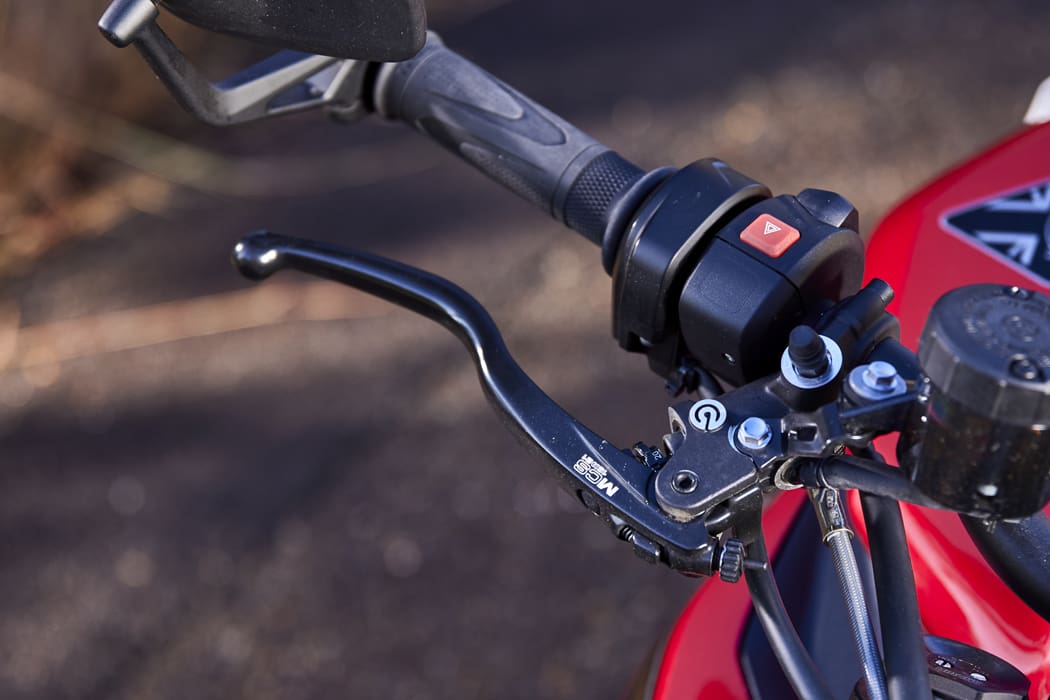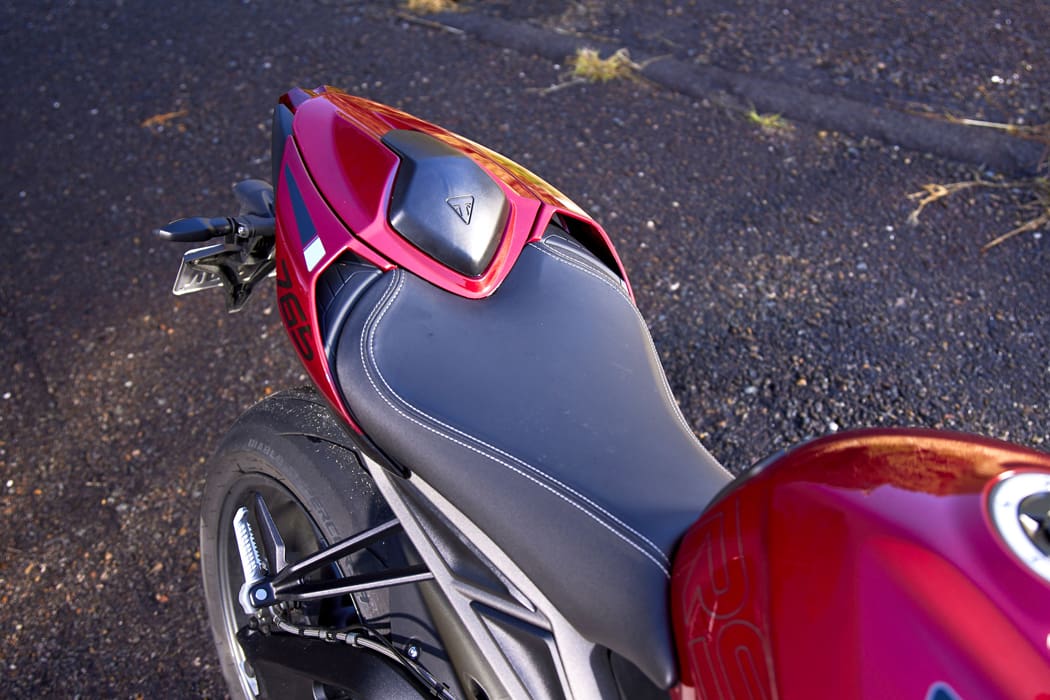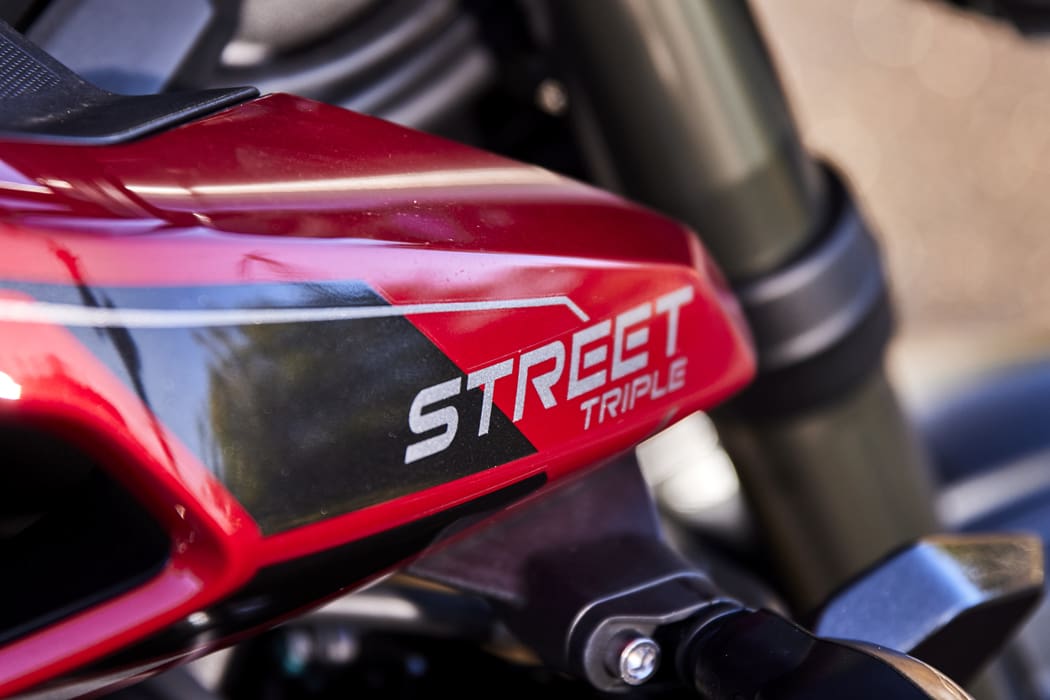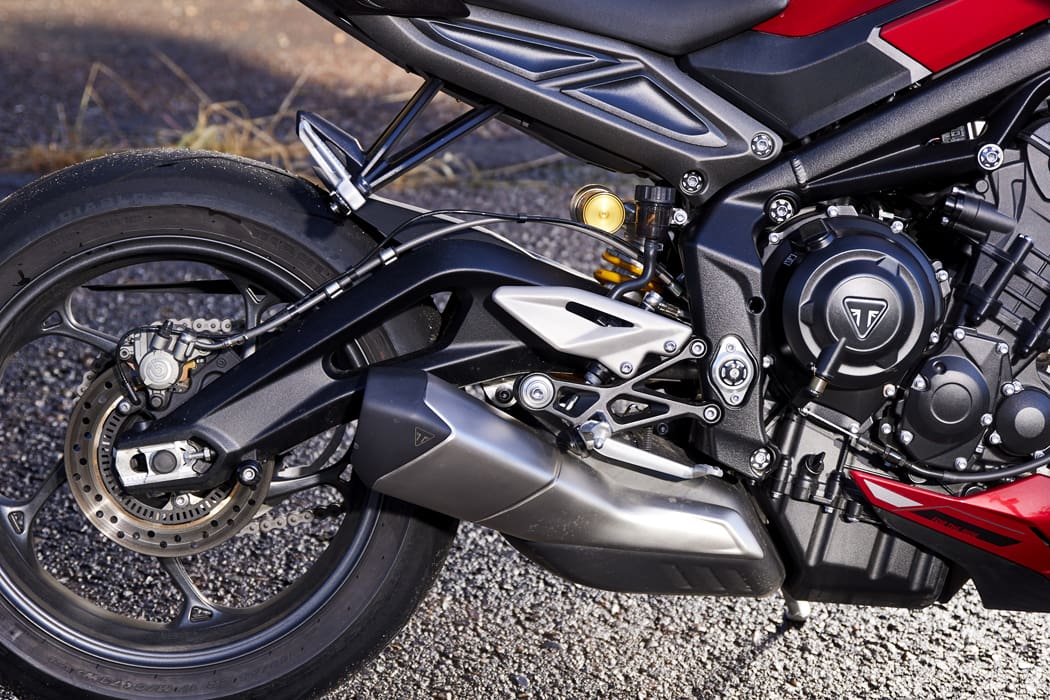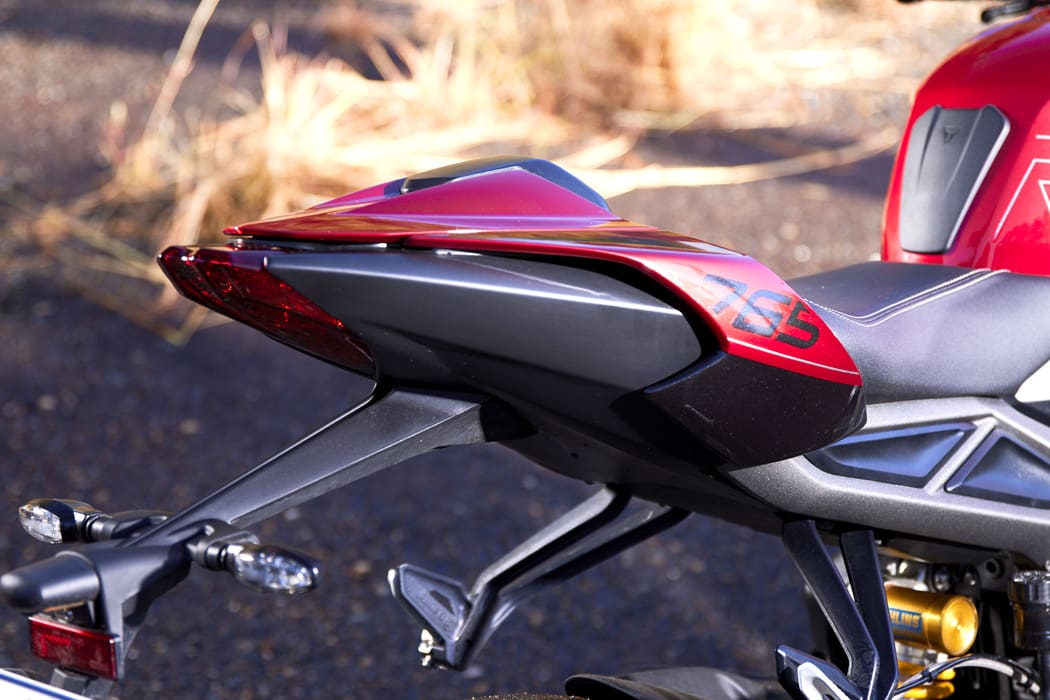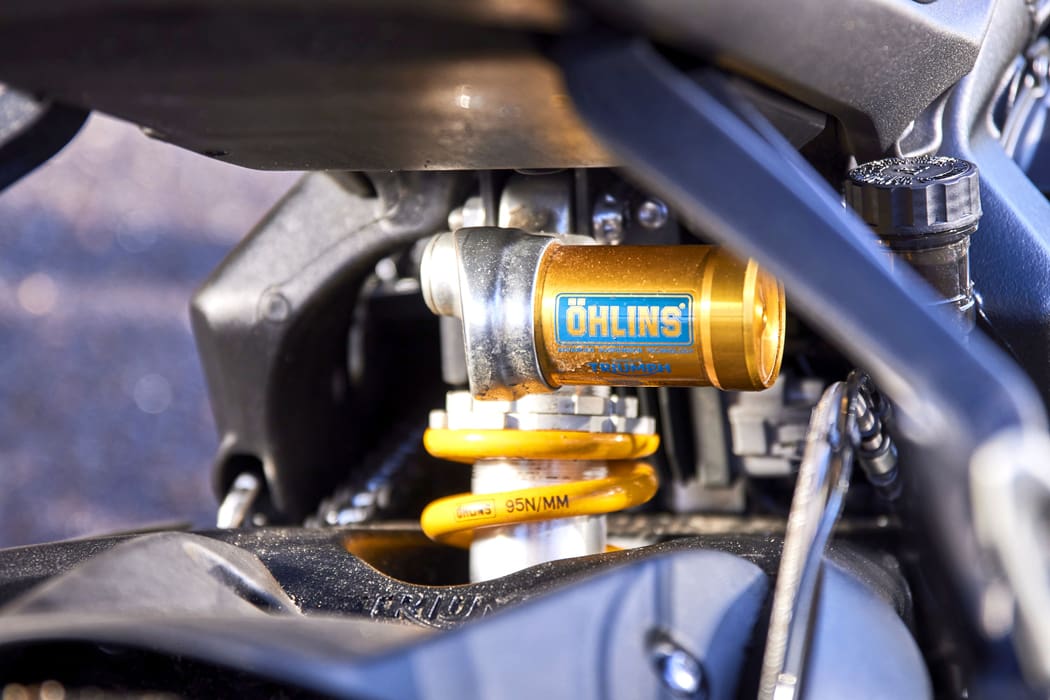Want a midsize nakedbike you can fang on both road and track? Ducati and Triumph have got you covered
Let’s get one thing straight: the Ducati Monster SP and the Triumph Street Triple 765 RS are midsize nakedbikes that are nothing like the ‘cheap and cheerful’ Japanese trio we tested on our Dumb & Dumber ride through the alpine regions of NSW a few months back.
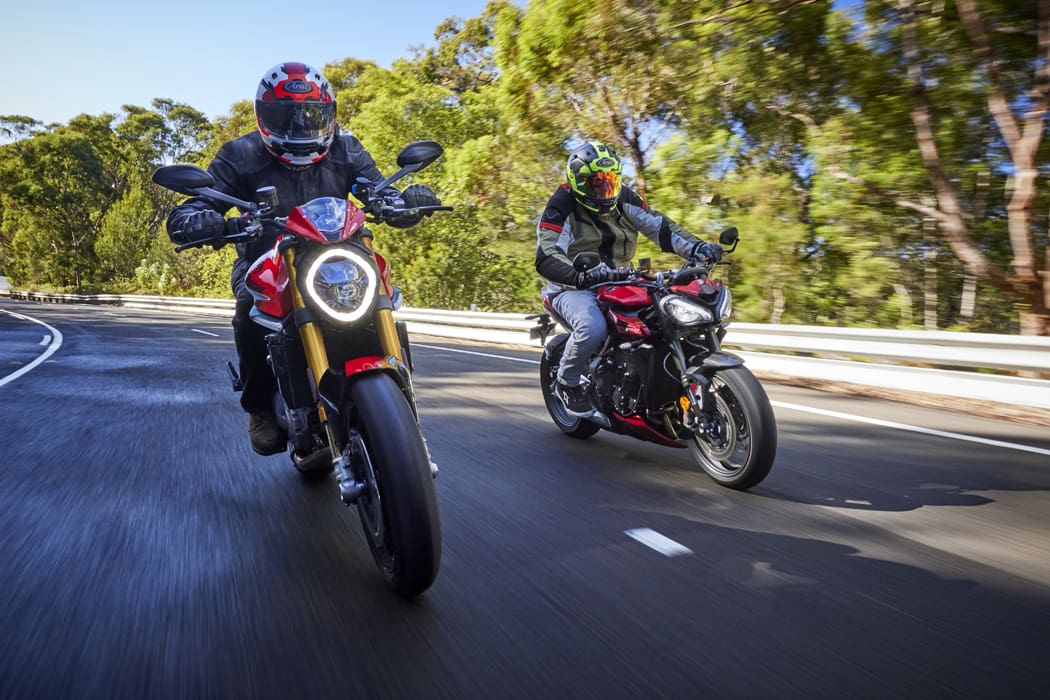
Sure, the Honda Hornet, Suzuki GSX-8S and Yamaha MT-07 are fabulous bikes, but they are built to a price and can be described as modern interpretations of the Universal Japanese Motorcycle, and for that very reason they won’t appeal to everyone, especially those after something more exclusive… with more power, better handling, better braking and more tech. Luckily, there are several midsize nakedbike alternatives that will definitely up the ‘cheerful’ factor, even if they don’t come ‘cheap’.
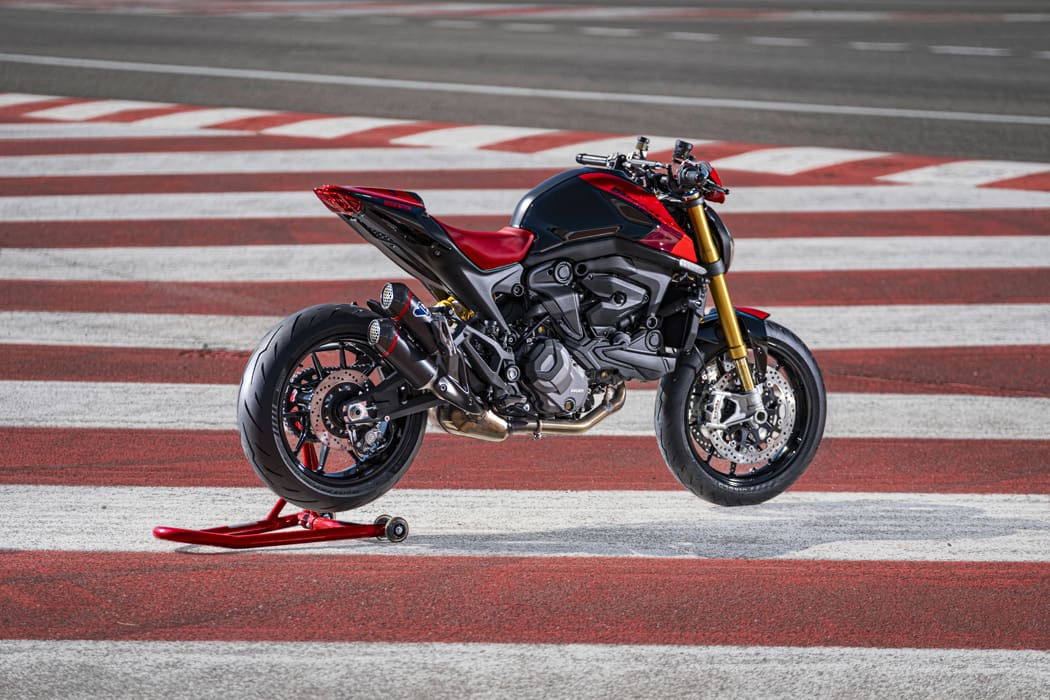
Two of those alternatives are the Ducati Monster SP and the Triumph Street Triple 765 RS. This pair of Euros are similar in size and weight as the Japanese trio, but both have way more grunt, top-shelf hardware, and are packed with the latest in high-tech electronic rider aids.
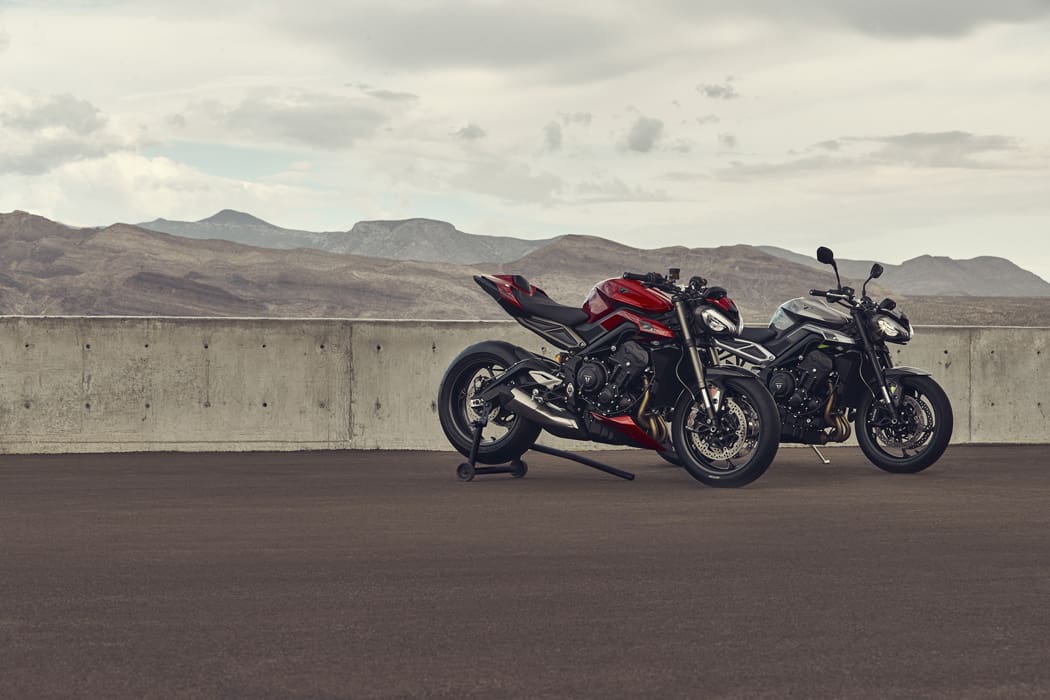
The Monster SP builds on the ‘new’ Monster with a cast aluminium frame that was launched in 2021. While some Monster purists found that hard to accept, any who have ridden the new bike would instantly appreciate how much better it is than the old trellis frame model.
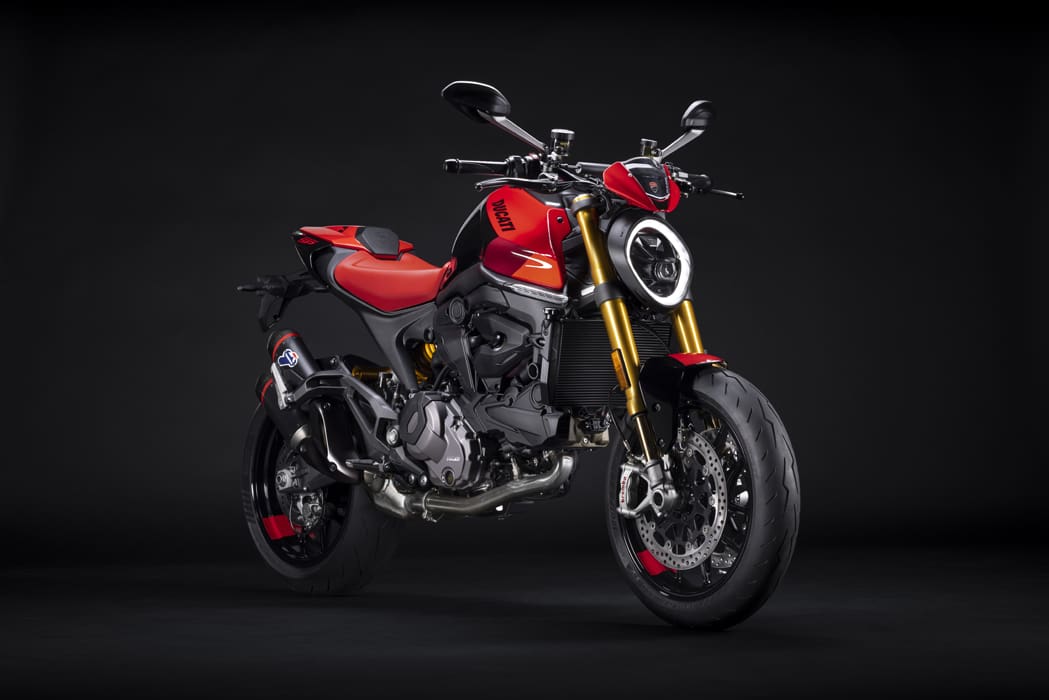
Even in base trim the Monster comes standard with a full suite of electronic rider aids including cornering ABS, traction control, wheelie control, launch control and selectable ride modes. And in this high-grade SP trim, Ducati has upped the ante further with the inclusion of Öhlins suspension, Brembo Stylema brakes, a new steering damper and trick-looking Termignoni silencers.
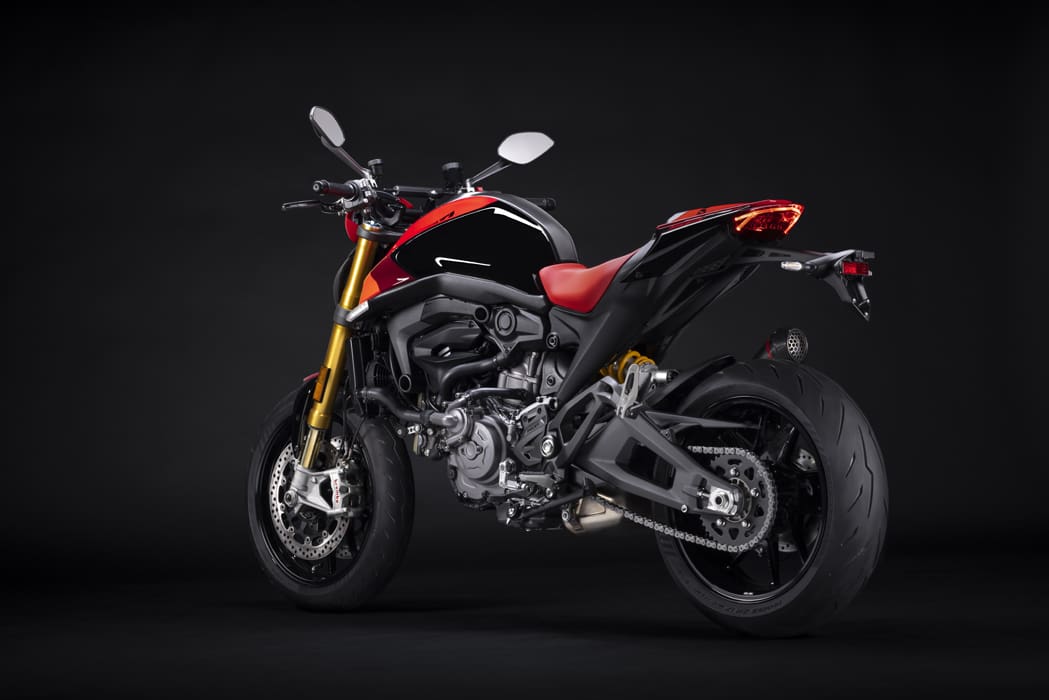
The addition of these top-shelf components to the Monster SP adds way more capability and fun, but it also adds to the cost; the SP will set you back $23,200 ride away, which is $4k more than the base-spec Monster and close to $10k more than one of the Japanese midsize nakeds.
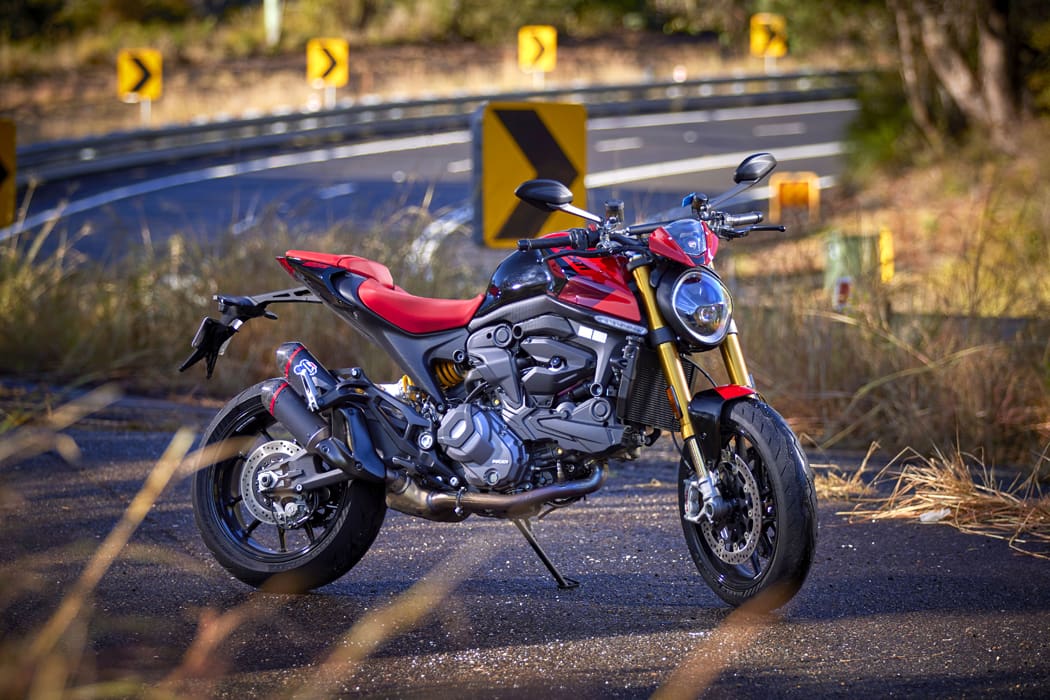
The other Euro alternative we’re looking at here is the Street Triple 765 RS. Launched earlier this year, the new Street Triple is an evolution of the previous model, with a more potent inline triple that is essentially the same engine Triumph supplies for the Moto2 world championship. In RS trim the Street Triple pumps out a claimed 95.6kW (128hp) of power, eclipsing the most powerful of the Japanese midsize nakeds (the Hornet, which makes a claimed 67.5kW) as well as the Monster SP (82kW).

Like the Monster SP, the Street Triple RS is significantly more expensive than the Japanese trio, but it comes in $2.6k under the Monster SP. Standard kit on the RS includes a Showa fork and Öhlins shock, Brembo Stylema brake calipers, cornering ABS, traction control, wheelie control and selectable ride modes.

For those with closer to $20k to spend than $15k, there are a couple of other alternatives like the $20,760 KTM 890 Duke R and the $18,899 Yamaha MT-09 SP but for now let’s focus on this pair of high-end nakeds from Bologna and Hinckley respectively.

Power supply
They might not be fire-breathing 160hp-plus litre-class nakedbikes, but make no mistake both the Monster SP and Street Triple 765 RS are bloody potent bikes that are an absolute blast to ride on the road and the track.
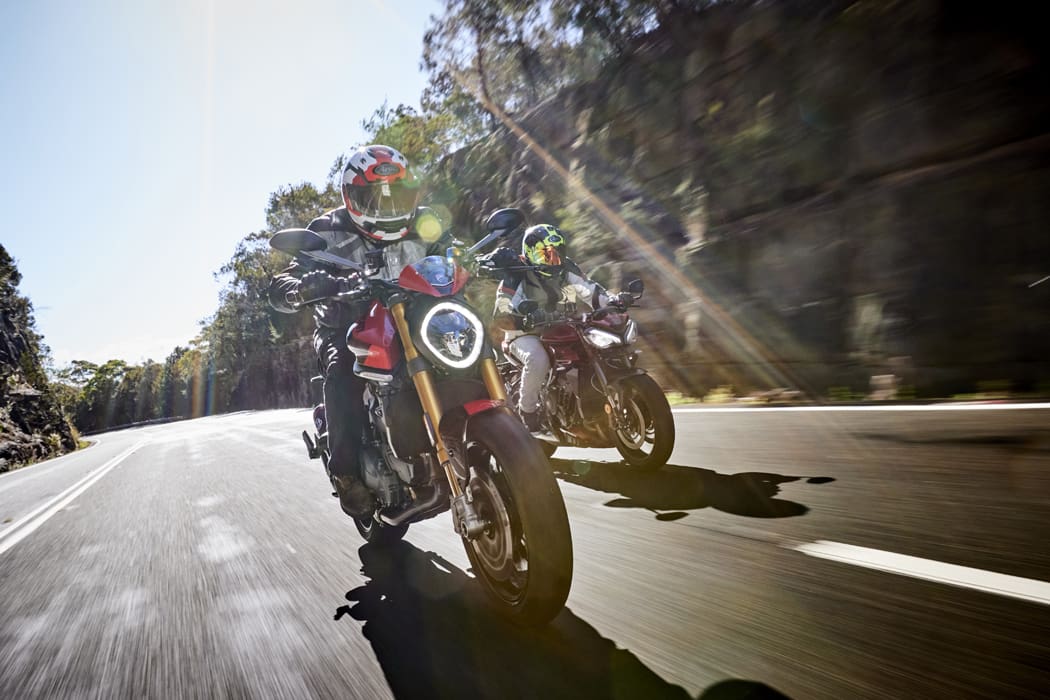
It’s in the engine room that these two sporty nakeds differ the most, with the Monster SP running Ducati’s traditional 90° V-twin layout that until recently was regarded as de rigueur for the marque, while the Street Triple 765 RS runs an inline triple in a nod to the format that has been at the heart of various Triumph models since the British brand’s rebirth in 1989. In the case of the Monster, that V-twin is the 937cc Testastretta engine, while the Street Triple runs a 765cc triple. When it comes to peak power the Monster SP is well down on the Street Triple RS, but with loads more torque from low in the rev range the Ducati has no trouble at all keeping up with the more potent Triumph on the road. In fact, in many ways, the Monster feels easier to pedal along at pace on the road thanks to its linear power delivery that peaks with a claimed 82kw (111hp) at a relatively low 9250rpm.
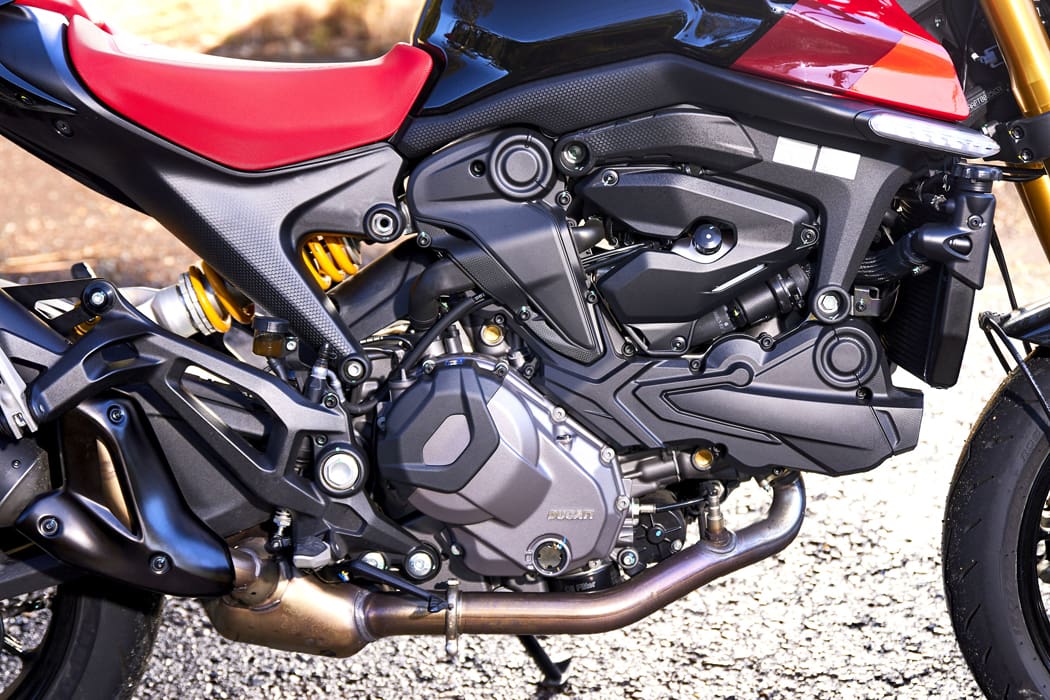
By contrast, the Street Triple makes its peak power of 95.6kW (128hp) at a heady 12,000rpm. Despite liking to rev, the Street Triple can’t be described as peaky because it too has a meaty midrange, but it simply can’t match the Monster for bottom-end grunt, the Italian making 93Nm of torque from just at 6500rpm compared to the Brit’s 80Nm, which comes in further up the rev range at 9500rpm.
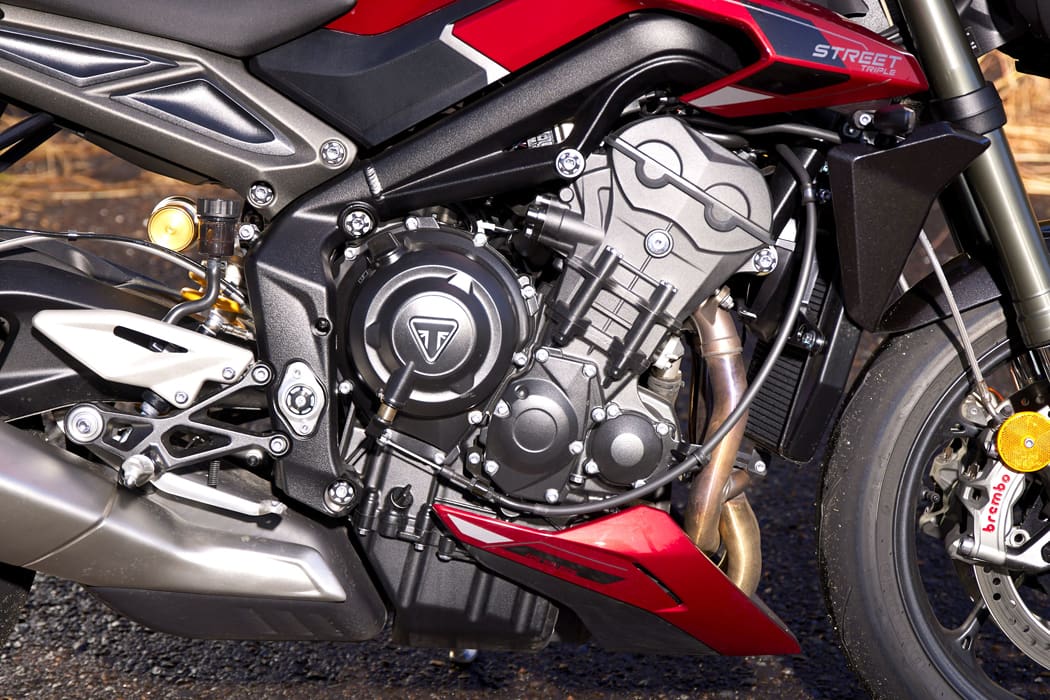
As a result, you can crack the Monster’s throttle open from as low as 3500rpm in almost any gear and the response is instant and seamless, aided by the well-sorted fueling that ensures there are no soft spots or hiccups as revs climb.
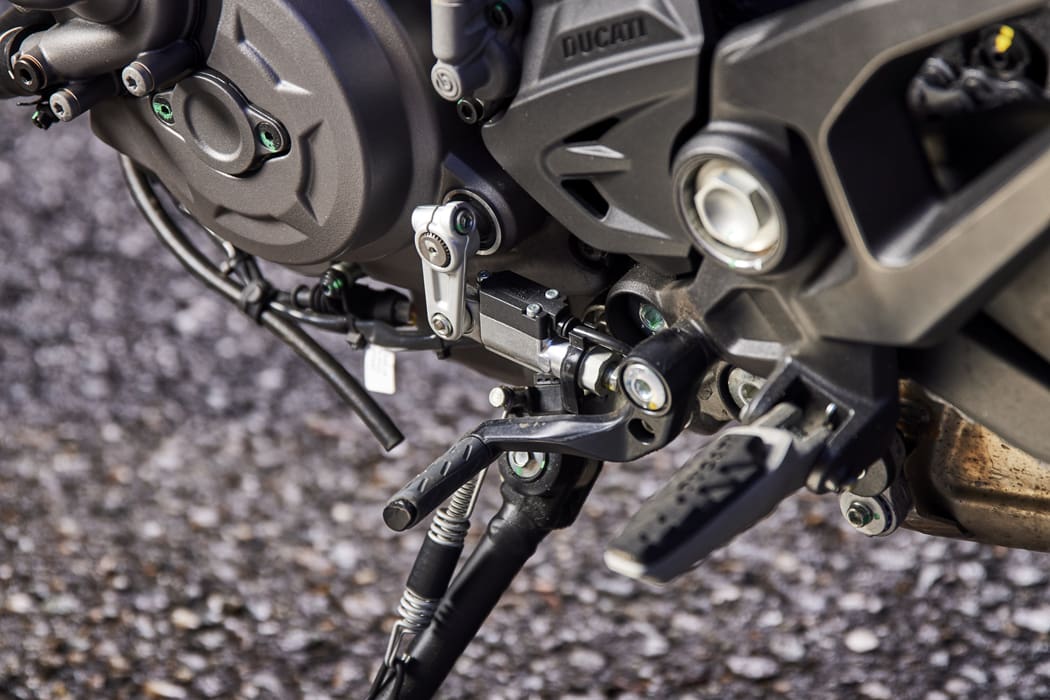
Although the engine’s flexibility means you barely need to work the gearbox, you won’t be able to resist the urge to downshift a cog or two for tighter corners because the bark from those twin Termignonis is intoxicating, as is the fabulous quickshifter.
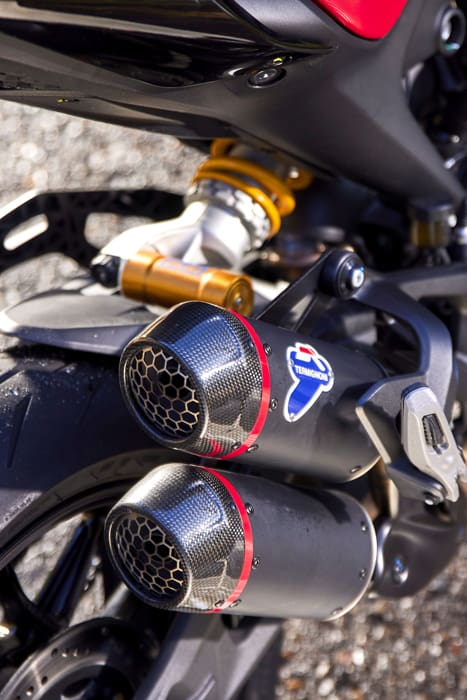
Although it plays a completely different tune to the Monster, the Speed Triple’s soundtrack is equally enticing thanks to its throaty induction roar and tasty exhaust note. To hang on to the Ducati through the tight stuff it pays to work the gearbox more on the Triumph, keeping the engine ticking along in the upper third of the rev range where things start to happen with some urgency and the tacho needle will race towards redline. Fortunately, the quickshifter on the Triumph is equally as good as the Ducati’s, so shifting through the six-speed ’box is a joy, not a chore.

Ones and zeros
Both of these midsize sportsnakeds offer the full gambit of electronic rider aids and ride modes to help you get the best out of each of them, no matter the conditions or your mood. They both feature cornering ABS, traction control and wheelie control, but only the Monster SP adds launch control to its impressive electronics arsenal. Once armed and with the throttle open, the launch control manages engine revs so you only need to focus on letting out the clutch for super fast standing starts. Fun? You betcha!
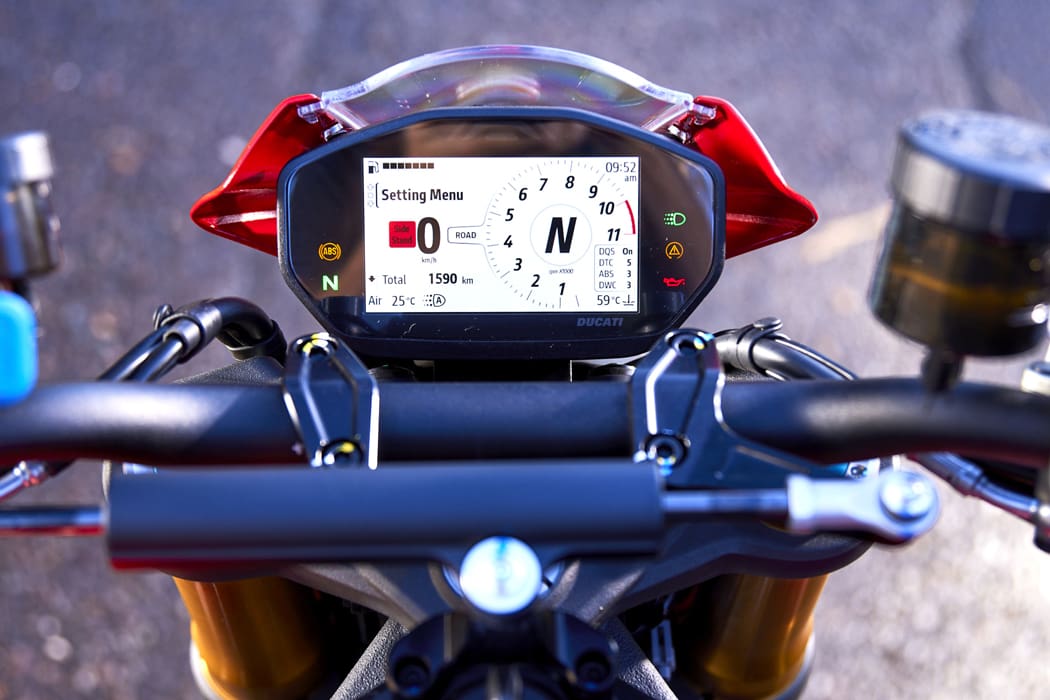
When it comes to rider selectable modes, both feature Rain, Road and Sport, which vary power output and delivery to suit different scenarios, along with changing other parameters such as the level of ABS and traction control intervention. In addition to these three modes, you can tailor individual parameters on the Monster SP such as ABS, TC and wheelie control, whereas the Street Triple RS adds Track and Rider configurable modes, in which Track provides the same throttle map as Sport but with less ABS and TC intervention, while Rider allows you to select between different throttle maps and ABS levels, as well as disabling TC and linked braking.

With ability to tailor so many parameters, some familiarisation is required to figure out the operation of all the settings on both bikes. Both have bright and clear TFT screens, which aid the cause, and after a bit of time with each you’ll soon be able to get them set up just how you want. And if it all gets a bit confusing, just select one of the pre-set modes – Rain, Road or Sport – until you can get your head around it.
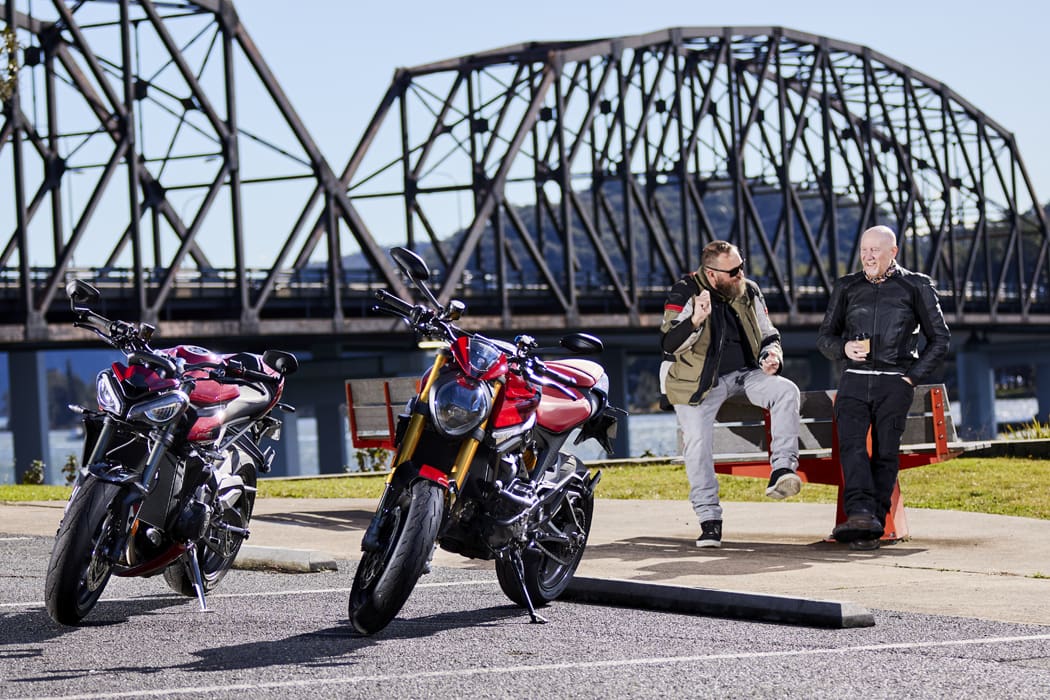
Grip and tuck
The Monster SP runs Öhlins suspension front and rear while the Street Triple RS has a Showa fork and an Öhlins shock. That front-end on the Monster SP is a fully adjustable 43mm USD fork with 140mm travel, while the rear Öhlins shock offers 150mm of travel. By contrast, the Street Triple RS’s fully adjustable 41mm Showa USD big piston fork offers 115mm of travel and the Öhlins shock has 131.2mm of travel.
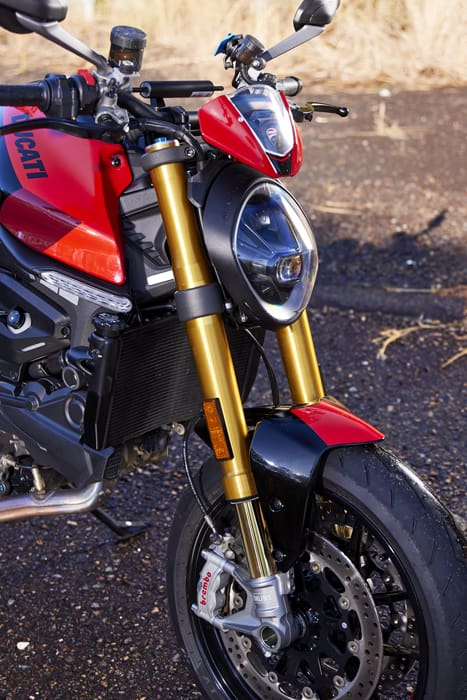
If you want a 43mm Öhlins fork on the front of your Street Triple to go with the Öhlins rear-end, you’ll have to open your wallet and step up to the limited Moto2 Edition, which will set you back $25,290 (if you can get your hands on one). As well as the upgraded suspension, the extra spend gets you carbon fibre bodywork, a machined and numbered top yoke and lower-set clip-on ’bars.
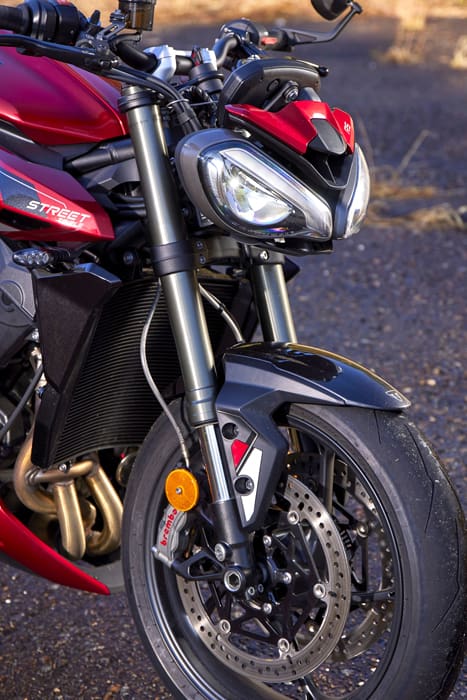
On this road-only test, there wasn’t a lot to pick between the SP and the RS in terms of ride comfort – both are on the firm side but with the Monster having the edge in terms of compliance over bumpy surfaces. With full adjustment front and rear we probably could have made the Triumph feel more compliant, but as Pete (110kg) and I (77kg) were swapping bikes throughout the test, we decided the standard suspension settings would be the best compromise. Regardless, the Monster’s extra wheel travel would likely have given it the edge in terms of compliance no matter what adjustments we made.

Tested in isolation, the Street Triple RS feels like one of the most flickable nakedbikes on the market, but not when ridden side-by-side with the Monster SP. Both bikes have a steep 23° rake angle but the SP feels easier to throw from side to side than the RS. On the flipside, the RS feels more stable when cranked over, and its front-end feels more planted, giving you the confidence to brake late and maintain impressive corner speeds. Both have ample ground clearance and if you find yourself scraping ’pegs on the road, then you should probably be riding at a track.
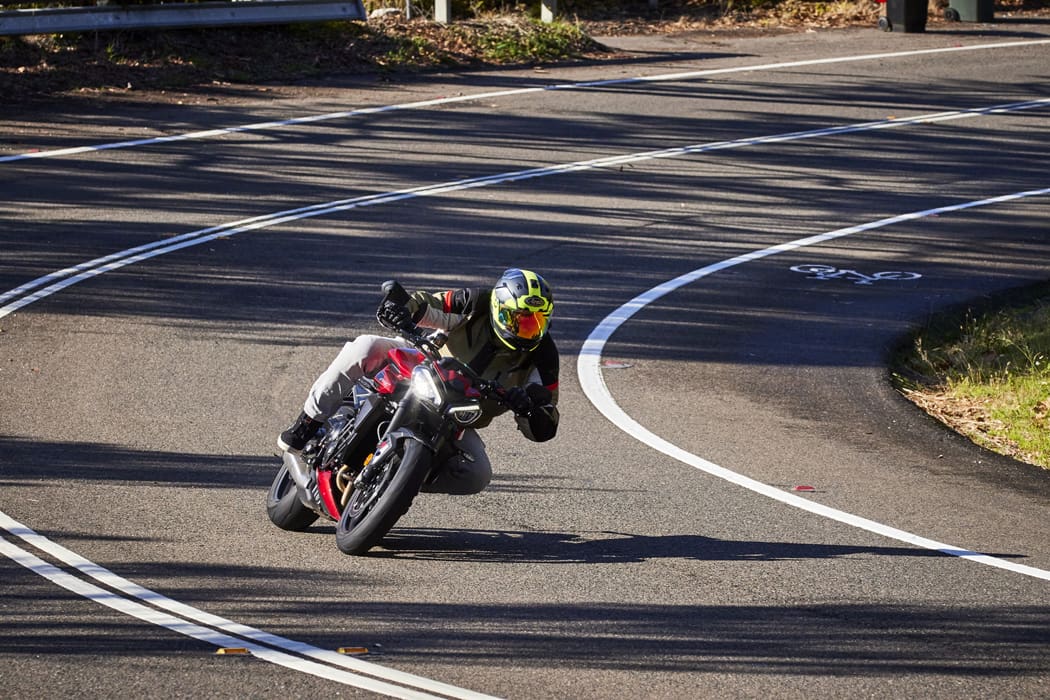
With its quick steering, light weight and punchy engine, squirting the Monster SP from corner to corner is a blast; just crack the throttle and feel the rear-end squat as it fires out of corners like a rocket. The Street Triple RS requires a bit more effort in the tight stuff, but as roads open up and speeds increase it’s extra power and planted chassis give it the performance edge.
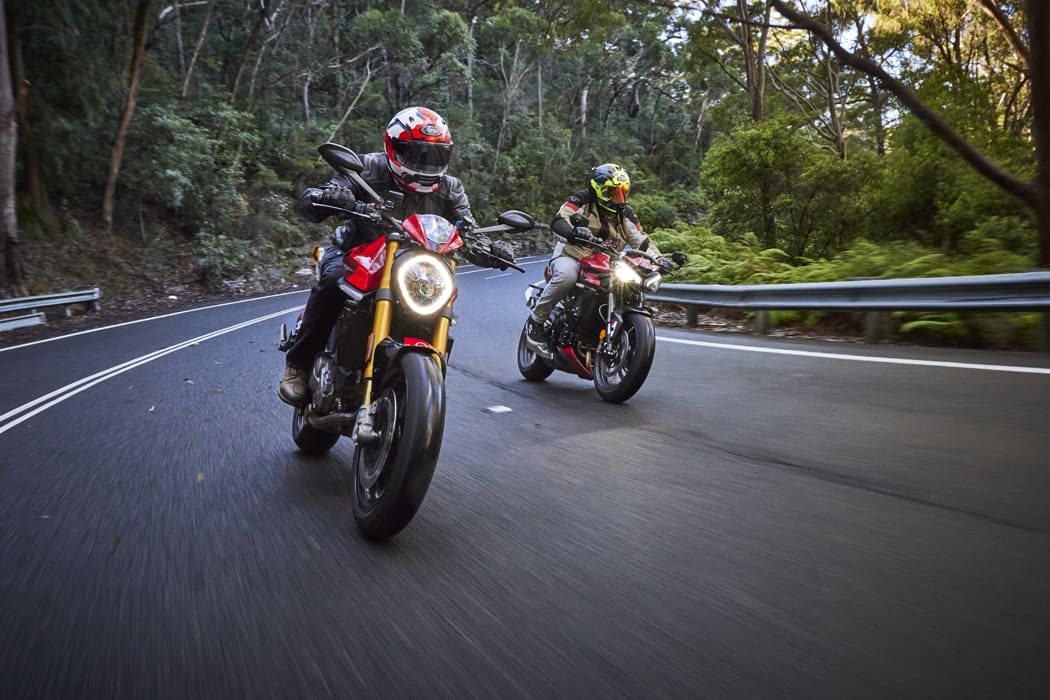
As for grip, on dry roads both have plenty thanks to the fitment of sticky Pirelli Diablo Rosso 4 rubber on the Monster SP and even stickier Pirelli Diablo Supercorsa SP V3 rubber on the Street Triple RS. In damp and sketchy conditions the Rosso 4s offer a bit more edge grip.
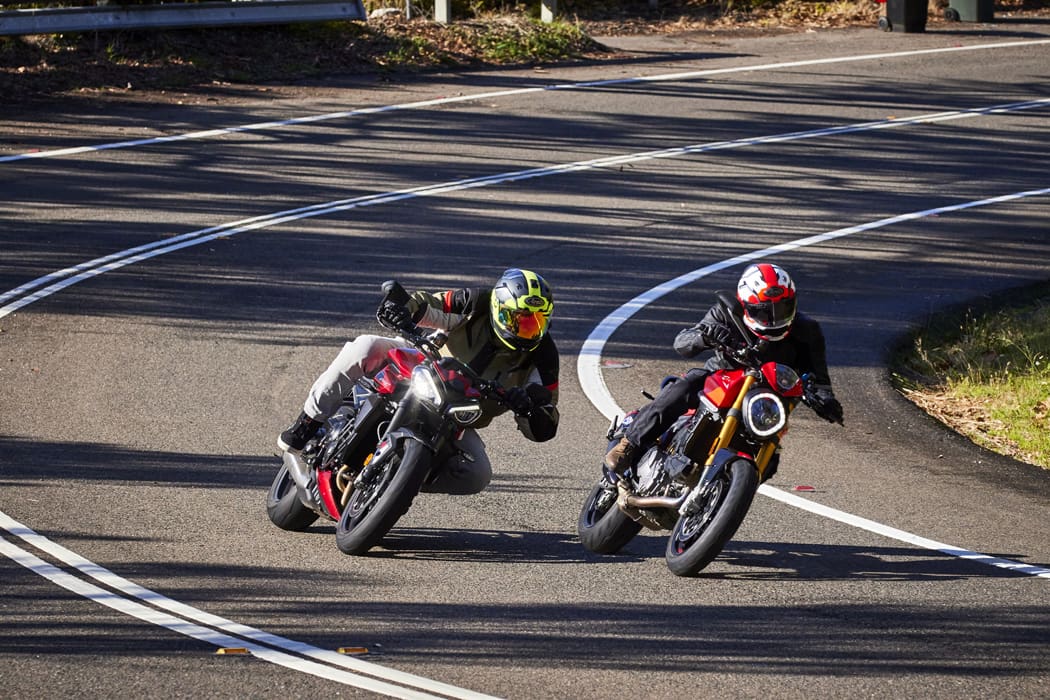
Full stop
Similar brake hardware and similar kerb weights make it difficult to pick between these two sporty nakeds when it comes to braking performance. Both stop on a dime, and they do so with fantastic feel and control.

Brembo Stylema calipers feature up front on both bikes, although the Monster SP has slightly larger rotors. The Italian also runs a slightly bigger rear brake but really, when it comes to deciding which bike has the most stopping power, it’s like splitting hairs.
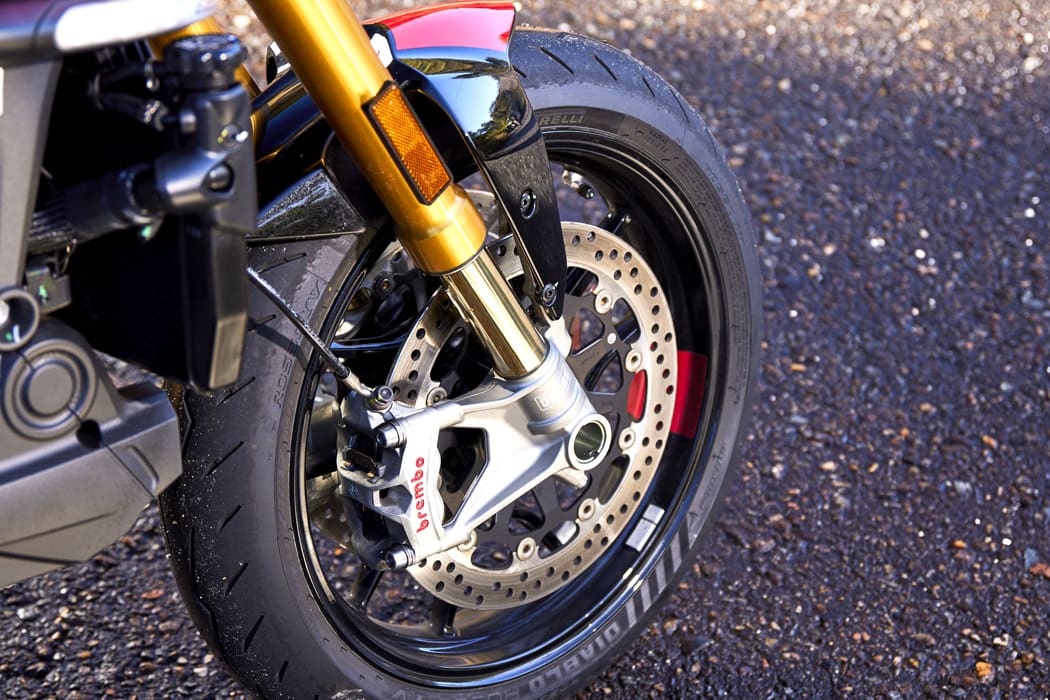
Feel at the lever is excellent on both bikes, although the Street Triple RS has the edge in this department with a Brembo MCS span- and ratio-adjustable front lever that allows you to tailor brake feel and response to suit your riding style and the conditions.

With such comprehensive electronics packages, the cornering ABS calibration is dependent on the ride mode selected on both bikes, and this again makes it difficult to pick between the two machines, suffice to say that neither are lacking in braking performance, feel and control.
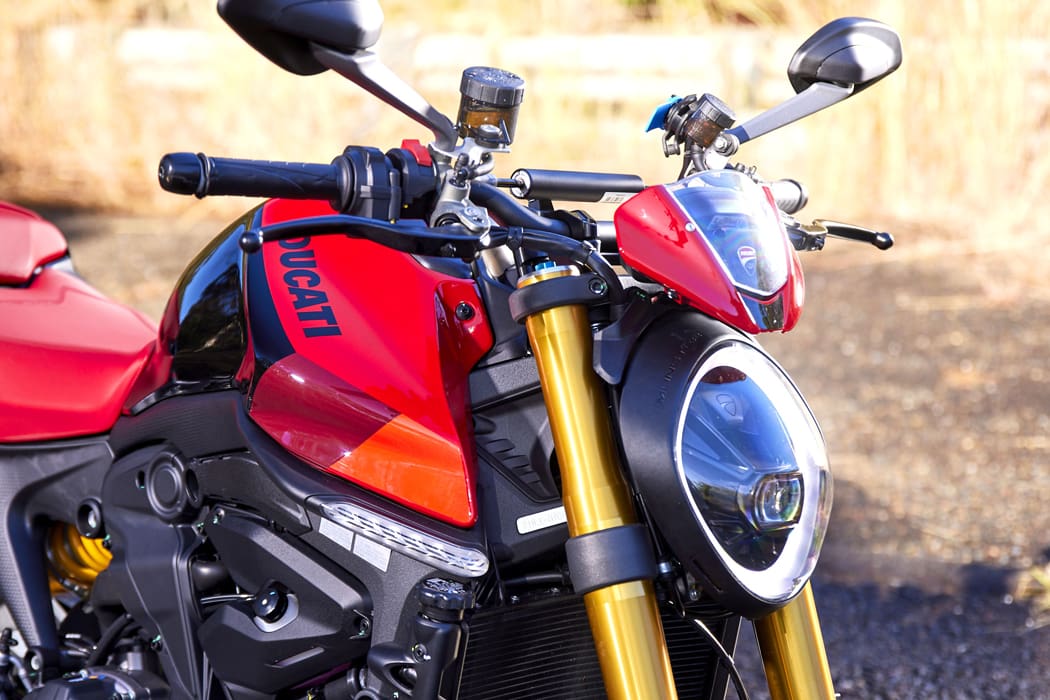
Room with a view
Despite similar dimensions and weights, the riding positions on these two bikes are quite different. Throw a leg over the Monster SP and it feels like you’re sitting in it rather than on top of it, whereas the raised rear-end of the Street Triple RS pushes more of your weight forward and over the front wheel.
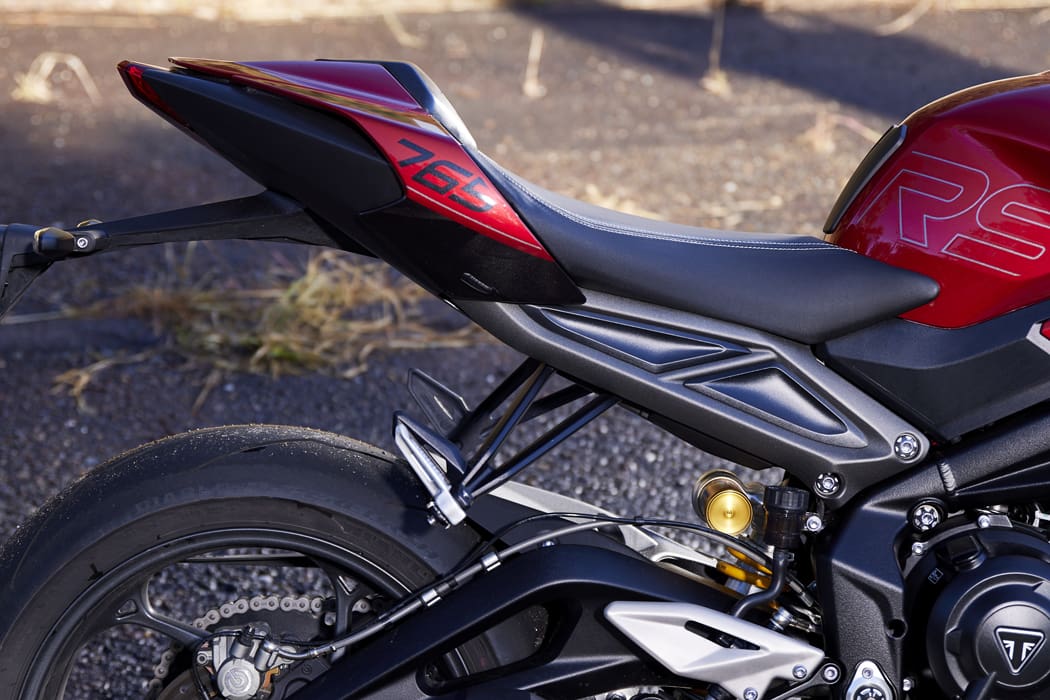
It’s surprising how different these two bikes feel to sit on when you consider there’s only a 4mm difference in seat height between the two of them, a 2kg weight difference, and similar rider triangles, with high-set ’pegs and a short reach to their respective handlebars.
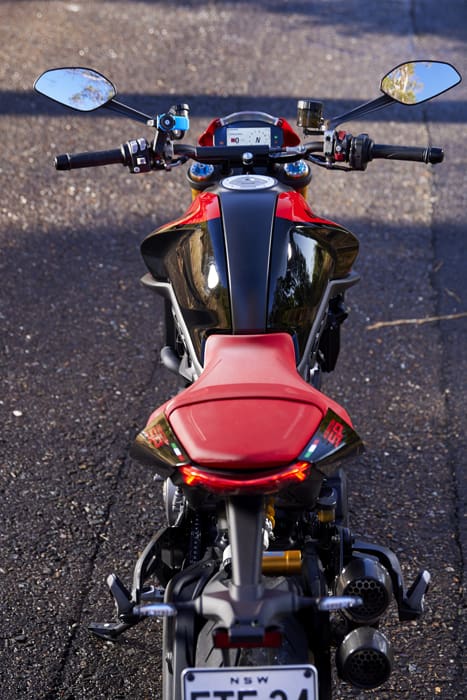
Both the Monster and Street Triple offer comfortable and upright riding positions that are well suited to real-world riding. Seat heights are quite high at 840mm for the Ducati and 836mm for the Triumph, but both manufacturers provide lower (and in the case of the Monster SP, higher) seat height options.
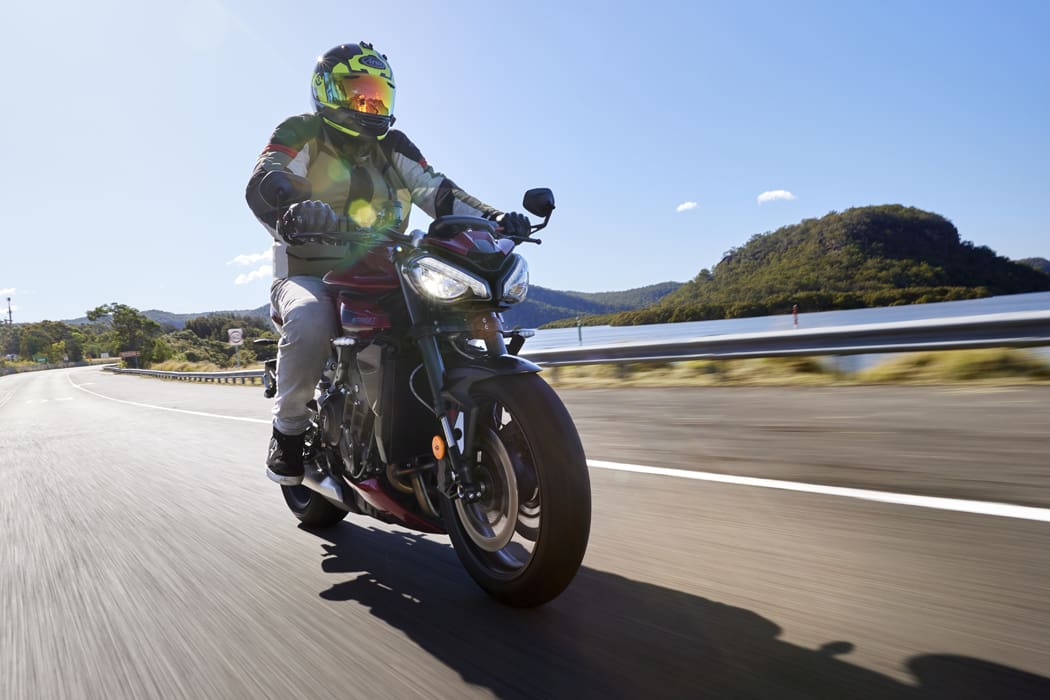
Around town they are lane-splitting masters; the Monster feels the smaller of the two and might not be as well suited to taller riders, but for those of modest stature (like me) it’s just about spot-on for comfort with a wide and supportive seat, nicely sculpted tank that you can grip with your knees, and a short reach to the handlebar. There’s slightly more weight on your wrists when seated on the Street Triple, but it’s by no means excessive, and it too offers a comfortable and well-padded seat.

Like any nakedbike on the open road, the lack of wind protection means you have to hang on as speeds increase, especially considering the performance on offer from these two. Both are capable of speeds well in escess of 200km/h and after having previously tested the 240km/h-speed-limited Street Triple RS on the track (Vol 72 No 18) I can assure you at high speeds you need a good grip to hold on to those wide ’bars. Both Ducati and Triumph offer screens for this pair, and if high-speed riding is on the agenda they would be handy extras.
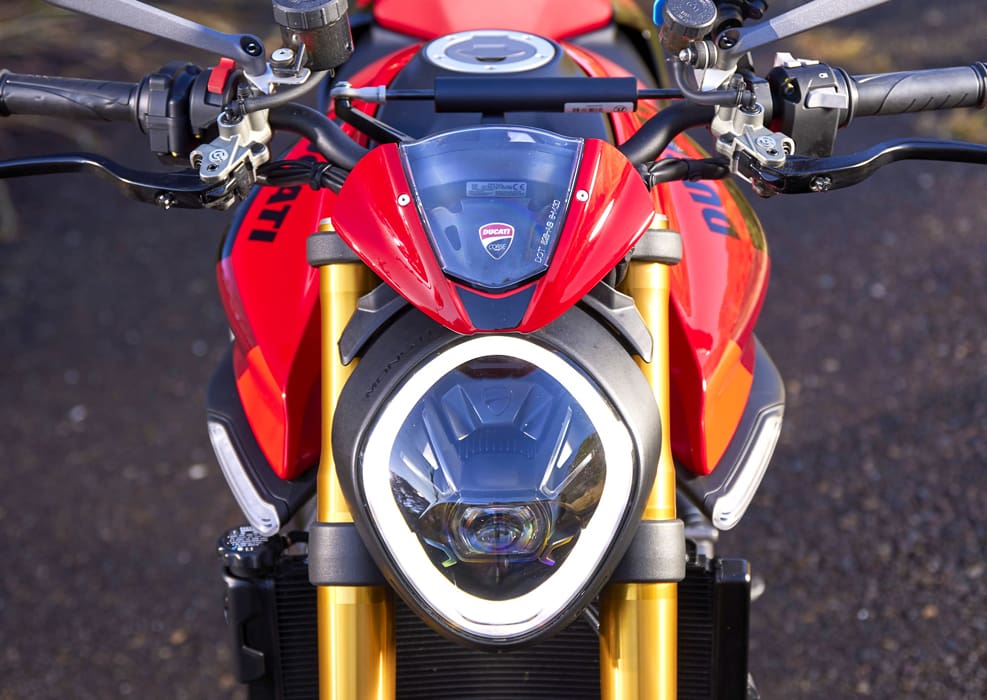
Horses for courses…
Which of these two midsize sportsnakeds offers the best value for money? That’s a bloody hard question to answer because they don’t quite match up spec-for-spec… although they are close when you look at the performance on offer and the hardware and tech employed to achieve it.

The Monster SP costs $2610 more than the Street Triple 765 RS, but you get that flash gold Öhlins fork on the Ducati. Of course, you can have that on your Triumph too, but you’ll have to find a Moto2 Edition that’ll cost you $2090 more again than the Monster SP.

What is fascinating about these two machines is how Ducati and Triumph have taken such different paths to come to a similar conclusion in providing high-end midsize nakedbikes that are a blast to ride on both the road and the track.
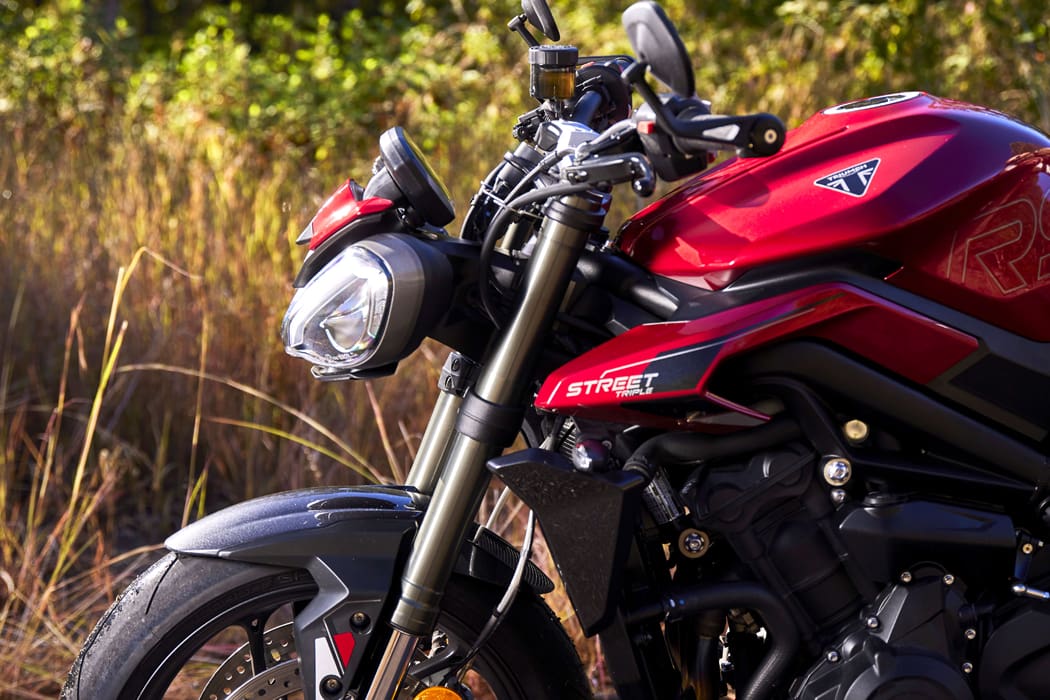
Take a look at the specs panels for each: sure, they have completely different engine configurations, but beyond that there are so many similarities, including their overall size and weight, suspension geometry, suspension and brake hardware and high-tech electronic aids.
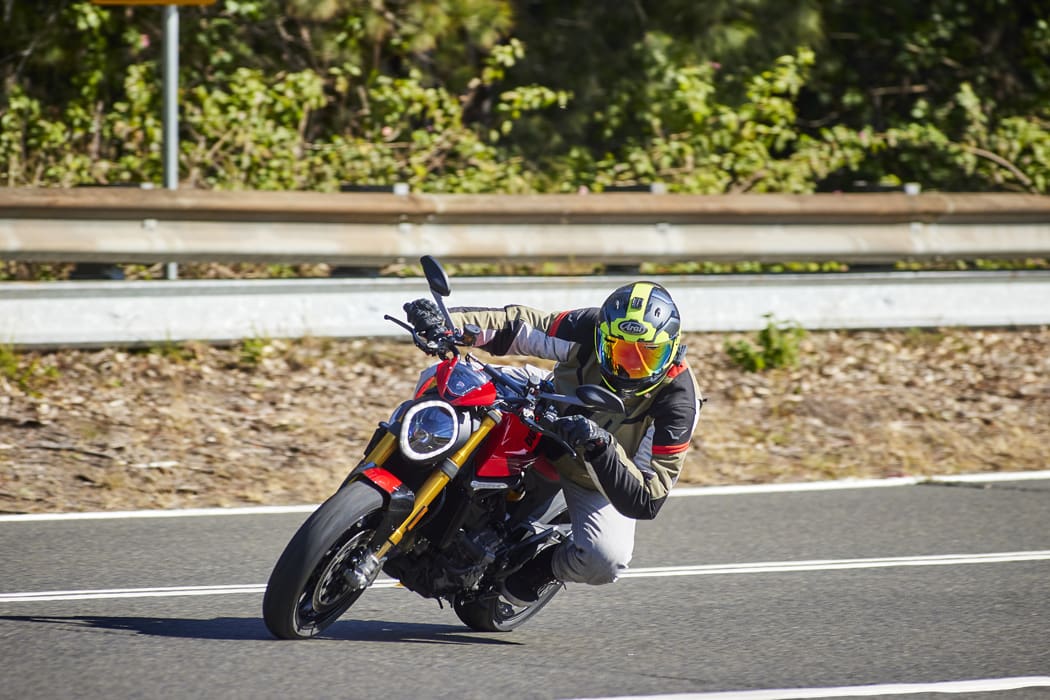
Both of these bikes are well-built and beautifully finished and to pick a winner would be doing the other an injustice. Of course, there will be those who have already made up their minds based solely on the badge on the tank, but even so I’d advise Ducatisti to at least sample the Street Triple 765 RS before laying down their cash, and Triumph devotees to likewise see if they can find a Monster SP to test.

I know, I know, it sounds like I’m sitting on the fence, and in a way I am, so I’ll finish off like this: if you live on a mountain and most of your riding is on tight, twisty roads, you need a Monster SP in your life… but if most of your riding involves fast sweepers and there’s a racetrack nearby, get down to your nearest Triumph dealer.

Test Dean Mellor + Photography Josh Evans
